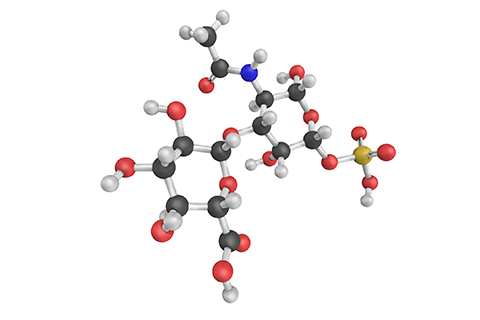From the journals: MCP
Amino acids and sulfate signatures. Unveiling phosphatase substrates. Simplifying bacterial proteome profiling. Read about papers on these topics recently published in the journal Molecular & Cellular Proteomics.
Amino acids and sulfate signatures

Chondroitin sulfate proteoglycans, called CSPGs, are complex molecules that surround cells and provide not only structural and biochemical support to various tissues in the human body, including the nervous system, cartilage, bone and connective tissues, but also influence organ differentiation and regeneration. They are comprised of a core protein to which chondroitin sulfate chains, or CS chains, are attached at specific serine residues. CS chains are long, linear sugars composed of repeating often sulfated units of glucuronic acid and N-acetylgalactosamine.
Sulfation can occur at different positions on the amino sugar and the uronic acid, leading to various sulfation patterns. These variations contribute to the diverse biological functions of chondroitin sulfate. Core protein structure, CS chain length and sulfation patterns vary widely in CSPGs, complicating the characterization of a standard representative sequence for a given CSPG. Chondroitin sulfate signatures may serve as biomarkers for certain diseases or conditions. Identifying unique patterns associated with specific health states can aid in the development of diagnostic tools.
Mass spectrometry is a powerful tool for sequencing CSPGs, but technical challenges still exist in determining how CS structures vary among them. In a recent article published in Molecular & Cellular Proteomics, Fredrik Noborn and colleagues from the Institute of Biomedicine at the University of Gothenburg report a novel glycoproteomics approach for characterizing the sequence of CS modification at specific sites of attachment to the core proteins.
With a combination of CS glycopeptide enrichment, using strong anion exchange chromatography, depolymerization of CS polysaccharides and nanoscale reversed-phase liquid chromatography-tandem mass spectrometry, the authors determined the sulfation patterns of CS in protein attachment sites of CSPGs in human urine samples. The approach showed that the acidity of amino acid sequences around the CS attachment site corresponds to higher sulfation levels in the CS chains. This approach will help researchers analyze the structure-function relationships of CSPGs in the future, which can guide the design of drugs for diseases with altered CSPG modifications.
Unveiling phosphatase substrates
The dynamic interplay between protein phosphorylation and dephosphorylation is fundamental to many cellular processes. Protein kinases and protein phosphatases are enzymes that add or remove phosphate groups to proteins, respectively, typically on serine, threonine or tyrosine amino acid residues. With advances in mass spectrometry and proteomic technologies, scientists have discovered thousands of protein phosphorylation sites. However, researchers have confirmed that less than 10% of these sites are phosphorylated by kinases and less than 1% are dephosphorylated by phosphatases.
A recent study published in the journal Molecular & Cellular Proteomics, led by Natasha C. Mariano and colleagues from the Geisel School of Medicine at Dartmouth, shows the potential for CRISPR-Cas9 gene editing, auxin-inducible degron, or AID, tagging system in conjunction with quantitative mass spectrometry and phosphoproteomics to identify dephosphorylation sites in cells. To validate this approach, the researchers determined the dephosphorylation sites for a serine-threonine phosphatase enzyme, protein phosphatase 6, also known as PP6.
The authors report a direct role for PP6 in regulating the function of Monopolar spindle-one-binder proteins, or MOB1, by dephosphorylating threonine 35 residue. This study links PP6 to the phosphorylation-based interaction of MOB1 and large tumor suppressor kinase, or LATS, a key player in the Hippo signaling pathway. The PP6 mutation in certain cancers such as melanoma leads to hyperactivation of the rapidly accelerated fibrosarcoma/mitogen-activated protein kinase/extracellular signal-regulated kinase, or RAF-MEK-ERK, signaling pathway. This signaling cascade often shows resistance to drugs, leading to therapeutic failure. Hence, effective multiplexed phosphoproteomic approaches that explore the signaling activities of individual phosphoprotein phosphatases will help design therapeutics that bypass drug resistance in cancers.
Simplifying bacterial proteome profiling
Bacterial proteomes can be complex and dynamic, varying across different growth conditions, stages of growth and environments. Heterogeneity in bacterial populations adds a layer of complexity, making it challenging to capture the full diversity of the proteome in a single quantitative proteomic workflow. Bacterial proteome analysis also involves handling live microorganisms, presenting biosafety concerns.
In a recent study published in the journal Molecular & Cellular Proteomics, Miriam Abele and a team at the Technical University of Munich report a safe, rapid, single-shot quantitative workflow for bacterial proteome characterization. The workflow combines microflow liquid chromatography with data-independent acquisition methods in a liquid chromatography–mass spectrometry system to achieve quick and superior open reading frame coverage of the proteome, as high as 65%. Conducting bacterial cell lysis using 100% trifluoroacetic acid eliminates the need for a bead-beating step or specialized instrumentation and ensures the safe handling of microbes.
The authors tested the workflow in 23 diverse bacterial species and performed a comparative proteome expression analysis encompassing 72 samples, illustrating the workflow's benefits in high-throughput applications. The proposed approach unlocks possibilities for bacterial proteomic studies on a large scale.
Enjoy reading ASBMB Today?
Become a member to receive the print edition four times a year and the digital edition monthly.
Learn moreGet the latest from ASBMB Today
Enter your email address, and we’ll send you a weekly email with recent articles, interviews and more.
Latest in Science
Science highlights or most popular articles

Bacteriophage protein could make queso fresco safer
Researchers characterized the structure and function of PlyP100, a bacteriophage protein that shows promise as a food-safe antimicrobial for preventing Listeria monocytogenes growth in fresh cheeses.

Building the blueprint to block HIV
Wesley Sundquist will present his work on the HIV capsid and revolutionary drug, Lenacapavir, at the ASBMB Annual Meeting, March 7–10, in Maryland.

Gut microbes hijack cancer pathway in high-fat diets
Researchers at the Feinstein Institutes for Medical Research found that a high-fat diet increases ammonia-producing bacteria in the gut microbiome of mice, which in turn disrupts TGF-β signaling and promotes colorectal cancer.

Mapping fentanyl’s cellular footprint
Using a new imaging method, researchers at State University of New York at Buffalo traced fentanyl’s effects inside brain immune cells, revealing how the drug alters lipid droplets, pointing to new paths for addiction diagnostics.

Designing life’s building blocks with AI
Tanja Kortemme, a professor at the University of California, San Francisco, will discuss her research using computational biology to engineer proteins at the 2026 ASBMB Annual Meeting.

Cholesterol as a novel biomarker for Fragile X syndrome
Researchers in Quebec identified lower levels of a brain cholesterol metabolite, 24-hydroxycholesterol, in patients with fragile X syndrome, a finding that could provide a simple blood-based biomarker for understanding and managing the condition.

